This sweet and savory Indian snack has a big crunch factor.
Prep: 15 mins
Cook: 20 mins
Total: 35 mins
Servings: 6 to 8 servings
Yield: 3 1/2 cups
Chivda, a delightful mixture of flattened rice, roasted lentils, peanuts, cashews, chillies, curry leaves, dried coconut, and other delectable ingredients, offers a symphony of flavors with every crunchy bite. Its irresistible taste is guaranteed to leave you wanting more, defying the possibility of stopping at just one bite.
Making Chivda for Diwali
This iconic Indian snack has earned its place as a beloved addition to school tiffins across the country, especially the couple weeks before Diwali vacation. A delicious and satisfying treat, chivda is also relished on Diwali evenings. Paired with chai and laddoos, it is a cherished part of the festivities, enhancing the joyous atmosphere as families gather to share laughter and stories.
Treats made on Diwali usually have a long shelf life as they are intended for sharing with neighbors and guests who drop by to celebrate the festival. While many of these snacks are enjoyed year-round, Diwali is an occasion to make all of these delicacies in substantial quantities, ensuring an abundant feast ready to be shared.
The Many Faces of Chivda
Much like other Indian dishes, chivda preparation varies across regions, offering distinct renditions. While some opt for the inclusion of dried fruits such as almonds and raisins, my family prefers a blend featuring only cashews. Divergent practices emerge in the realm of garnishes as well—some favor fresh coconut, while others opt for dried red chillies to enhance the dish's visual and flavor appeal.
How To Make Chivda
Making chivda might take some time, but the result is worth it. To start, dry roast the flattened rice and add turmeric powder and salt, setting it aside. Then individually fry other components such as chilies, dalia dal (roasted split chickpeas), curry leaves, cashews, dried coconut slices, and peanuts, adding them to the previously roasted flattened rice.
Upon frying all the ingredients, a thorough mixing on low heat with a subtle addition of sugar is all that's required to finish this crunchy snack.
What’s the Difference Between Chivda and Poha?
Both dishes derive from flattened rice, which is called “poha” in Hindi. The dish poha is a breakfast dish prepared using a thick variety of poha (flattened rice), which is soaked and subsequently cooked with ingredients like chopped onions, chillies, and potatoes. In contrast, chivda is a crispier snack made from the thin variety of poha with other dry ingredients.
Tips for Making Chivda
- Sun dry the poha for quicker toasting—Drying the poha in the sun (for about 2 to 2 1/2 hours) before dry roasting quickens the roasting process.
- Microwave the peanuts instead of frying—You can microwave the peanuts instead of frying them, as it's faster. Spread the peanuts on a microwave-safe plate and microwave them in 30-second bursts until roasted and fragrant, about 90 seconds total.
- Where to source the ingredients—A decent Indian market will have everything you need to make chivda, but ingredients can also be purchased online.
Make Ahead
Chivda can be made 2 to 3 days in advance and will look and taste fresh when served, if stored correctly.
“This chivda recipe was wonderful! The mixture was fragrant, crisp, and mouthwateringly delicious! It’s definitely very hard to stop eating. Be sure to purchase soft roasted split chickpeas for this snack.” —Diana Andrews
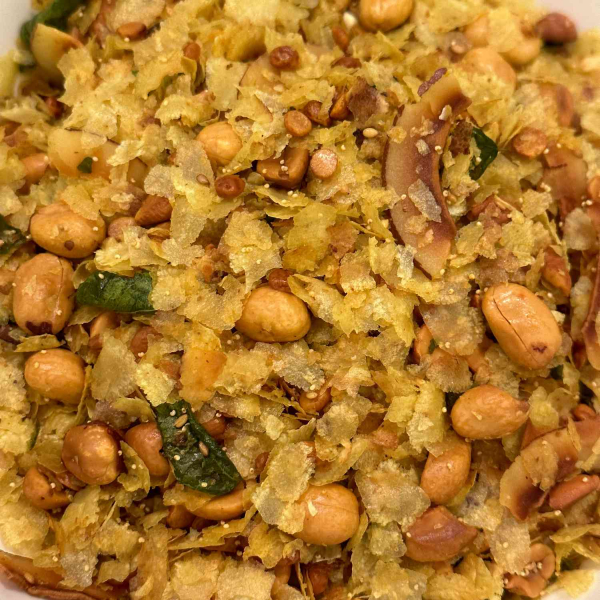
A Note From Our Recipe Tester
Ingredients
-
2 cups thin flattened rice (poha)
-
1/2 teaspoon ground turmeric
-
1/2 teaspoon fine salt
-
1/2 cup neutral oil, such as peanut or canola
-
1/2 cup raw peanuts
-
1/4 cup raw cashews
-
1/4 cup daliya dal, or chana dalia (split chickpeas)
-
1/4 cup dried coconut slices or flakes
-
4 Indian or Thai green chillies, or 1 small serrano pepper, finely chopped (or to taste)
-
15 to 20 fresh curry leaves
-
1 teaspoon raw sesame seeds
-
1 teaspoon poppy seeds, preferably white
-
2 pinches asafoetida, optional
-
1 to 2 teaspoons confectioners’ sugar
Steps to Make It
-
Gather the ingredients.
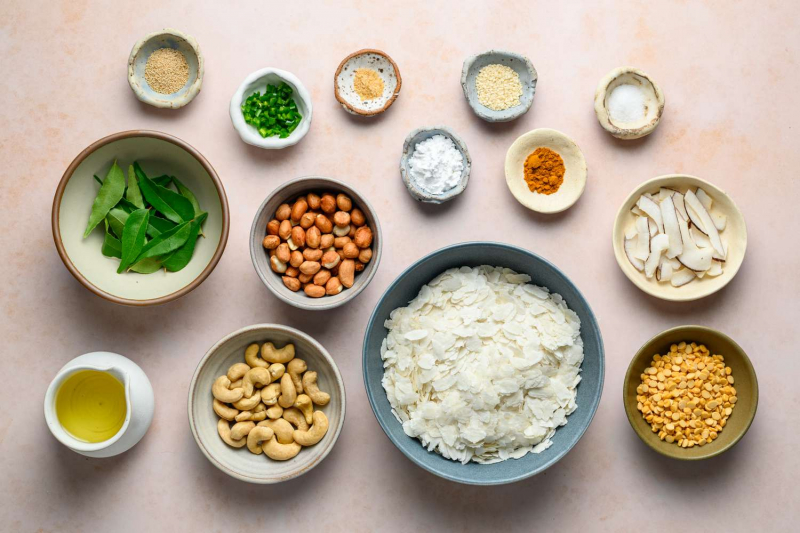
-
In a dry wok, on low heat, dry roast 2 cups thin flattened rice (poha), shaking the pan occasionally, until it becomes very dry and crisp, 5 to 6 minutes (avoid any browning). To check if it's roasted properly, press together 1 or 2 poha flakes; they should turn into a powder.
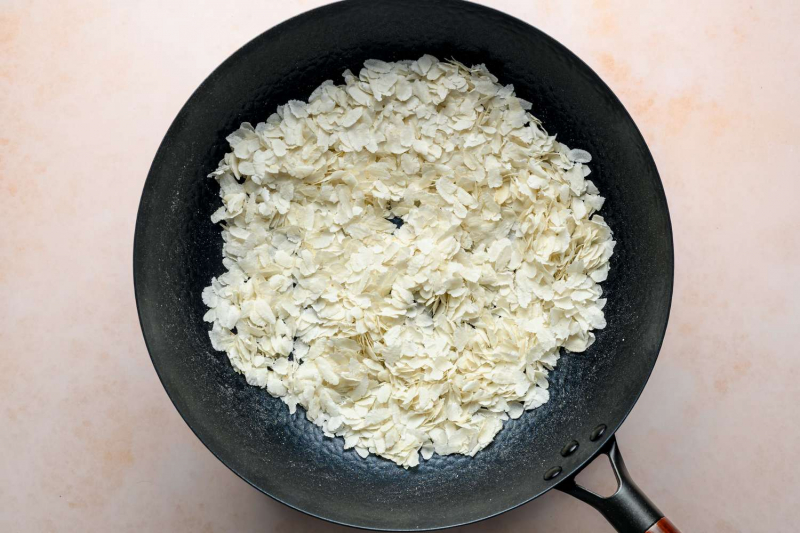
-
Transfer to a large bowl, sprinkle with 1/2 teaspoon ground turmeric and 1/2 teaspoon fine salt (don’t mix at this stage), and set aside.
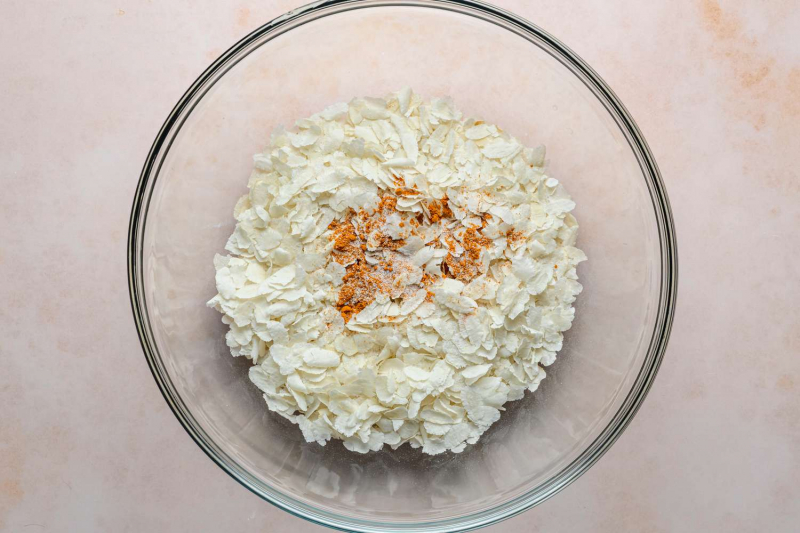
-
Wipe the wok clean. Add 1/2 cup neutral oil to the wok and heat over medium until it shimmers. Add 1/2 cup raw peanuts and fry, stirring occasionally, until they turn crisp and golden.

-
Remove the peanuts with a slotted spoon leaving as much of the oil behind as possible, and sprinkle them over the reserved poha.

-
Repeat the frying process with 1/4 cup raw cashews, 1/4 cup daliya dal, and 1/4 cup dried coconut slices or flakes, frying each ingredient separately until lightly toasted. Transfer to the poha mixture as they become done.
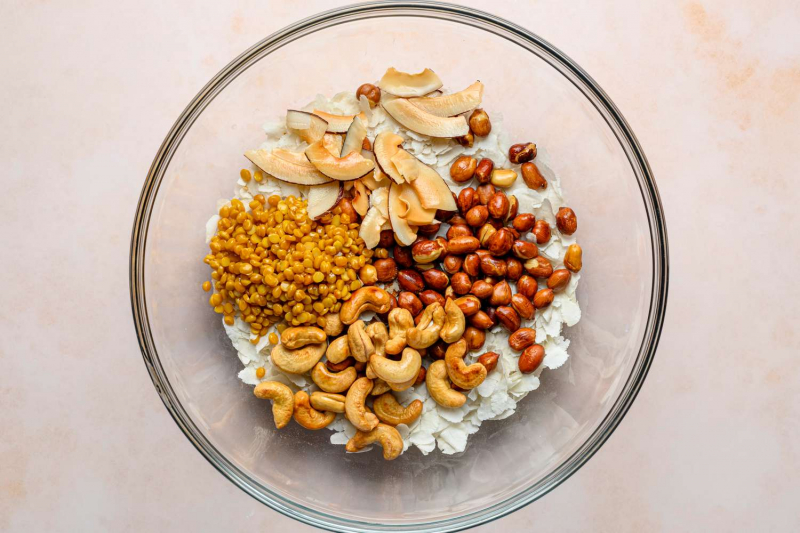
-
Fry 4 Indian green chillies, finely chopped and 15 to 20 curry leaves until they turn crispy, then add them to the poha.
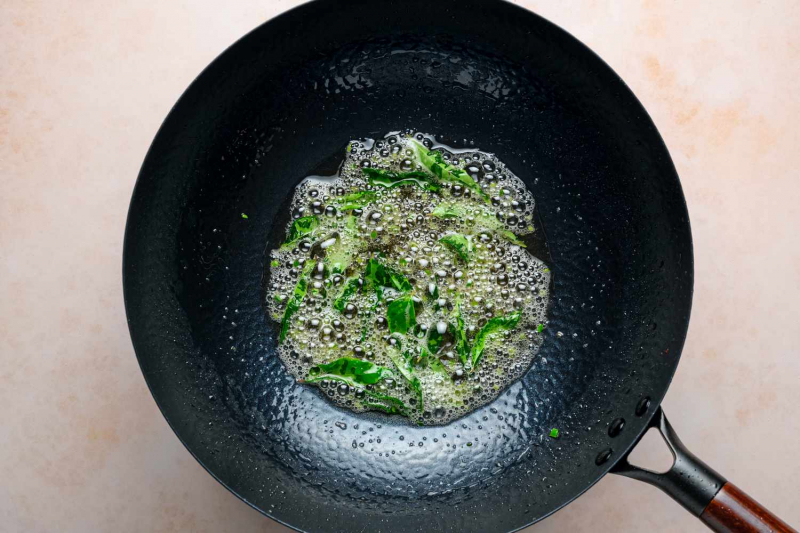
-
Drain all but about 1 tablespoon of the remaining oil from the wok and discard. Fry together 1 teaspoon raw sesame seeds, 1 teaspoon poppy seeds, and 2 pinches optional asafoetida, stirring constantly until golden.
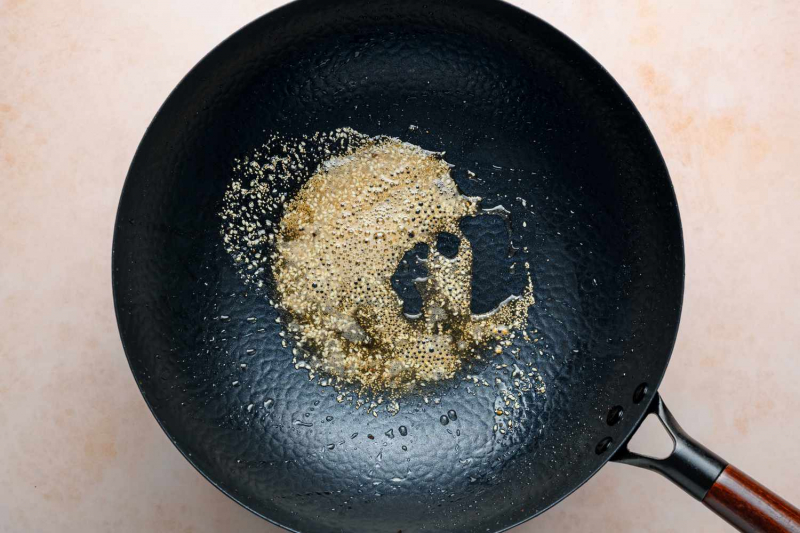
-
Return the poha mixture to the wok and gently fold the ingredients together over low heat until the poha flakes turn yellow, 2 to 3 minutes.
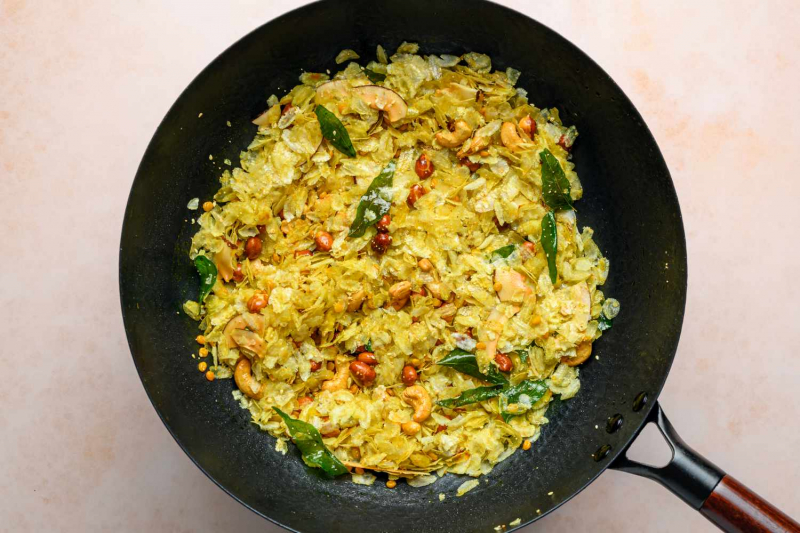
-
Remove from the heat and allow the chivda to cool. Add 1 to 2 teaspoons confectioners’ sugar and mix thoroughly before serving or storing.

How To Store
Chivda can be stored in airtight containers at room temperature for up to 2 weeks.
Feeling Adventurous? Try This:
- Omit the poppy and sesame seeds—Poppy seeds and sesame seeds are traditionally used during Diwali preparations to enhance the chivda's richness in flavor. However, you have the option to omit these ingredients if desired.
- Use a different type of poha—Alternatively, you can prepare the chivda using nylon poha, which is a thinner variety of poha. The overall procedure remains the same, but please note that the roasting time will significantly decrease due to the thinner nature of nylon poha.
- Make it spicier—If desired, you can include 6 small dried red chillies, such as Kashmiri chillies.
- Add raisins—Add 1/4 cup raisins or golden raisins after the chivda has cooled.
| Nutrition Facts | |
|---|---|
| Servings: 6 to 8 | |
| Amount per serving | |
| Calories | 188 |
| % Daily Value* | |
| Total Fat 13g | 16% |
| Saturated Fat 2g | 10% |
| Cholesterol 0mg | 0% |
| Sodium 155mg | 7% |
| Total Carbohydrate 15g | 6% |
| Dietary Fiber 2g | 6% |
| Total Sugars 3g | |
| Protein 5g | |
| Vitamin C 1mg | 3% |
| Calcium 26mg | 2% |
| Iron 1mg | 6% |
| Potassium 133mg | 3% |
| *The % Daily Value (DV) tells you how much a nutrient in a food serving contributes to a daily diet. 2,000 calories a day is used for general nutrition advice. | |

